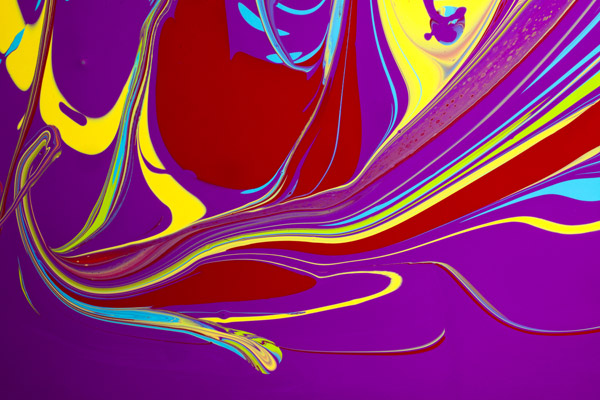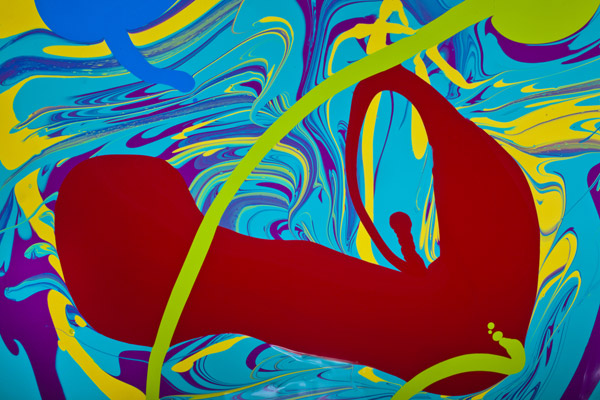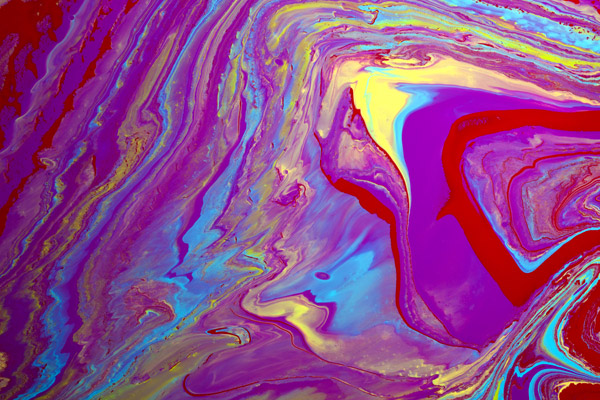Designs In Paint - Swirling Color, Close Up
Photography has taught me to be aware of color, design and patterns, and I am always looking for something interesting to photograph. A few years ago when my wife was making a marble cake, I was drawn to the design in the swirling chocolate and thought it would make a successful abstract shot. I liked the images I took, but I felt more color would make the pictures a lot more interesting.
That’s when it occurred to me to try photographing paint. I could choose any color combination imaginable, from complementary colors like cyan and red or blue and yellow to shocking color combinations like brilliant orange and lime green. The paint could be swirled together just like the cake mix, or it could be combined in other ways like allowing drops of one color to fall into a container of another color. Using a variety of implements such as a fork, a paperclip, or a spatula, the colors could be blended together in endless patterns and designs.
To experiment, I went to a local paint store and bought half-pint sized paint jars of a variety of colors. I poured various colors together into a shallow plastic container (#1), mixed them together and photographed the designs. I could have chosen to pour the paint onto a large piece of cardboard or foam core, but I wanted to contain the liquid and mix the colors together while they had thickness and depth. On a flat surface like cardboard, the paint wouldn’t mix together in a way that produced the kind of designs you see here.

All Photos © Jim Zuckerman
I used two different types of light—open shade and flash. To avoid harsh reflections in the wet paint from on-camera flash, I placed a single flash unit off-camera and triggered it with a Pocket Wizard (www.pocketwizard.com). I preferred to shoot the paint design when it was still wet because it glistened and the colors were more intense. When I used the soft light of shade, the colors tended to be more bluish than when flash was used. I set the white balance to cloudy, although it would be very easy to tweak the color bias in Adobe Camera Raw or Lightroom by moving the temperature slider toward the warmer part of the spectrum.
My preference, though, was to use flash, and for this I used the Daylight White Balance setting. By placing the flash close to the paint (about 12” away), I had the luxury of using f/32 while hand holding the camera. This allowed me the flexibility to shoot many designs quickly without being inhibited by a tripod.
When I was using a fork to mix the colors, at one point it slipped out of my hand and fell into the paint. I thought it looked so cool that I moved in very close and did a macro shot of it (#2). This was a happy accident, and it then occurred to me that other kinds of objects could be used as well.

When you first pour the paint together, you get fairly simple artistic designs like (#3, #4 and #5). As the colors mix together more thoroughly, more complex images appear—(#6, #7 and #8). Sometimes I tilt the container a few times and let the colors mix randomly, and some of the most amazing images can be taken this way. I bought six colors of paint to work with, and this was plenty. But if you want to alter any of the paint colors, you can do so in Photoshop or Photoshop Elements in the Hue/Saturation dialog box (Image>Adjustments>Hue/Saturation in Photoshop). An example of this is (#9).







It was very important to make sure the back of the camera (i.e. the plane of the sensor) was parallel with the surface of the paint. This helped maintain sufficient depth of field at any lens aperture because each point on the paint’s surface was equidistant with the sensor. When the camera was positioned at an oblique angle, it was more difficult to obtain tack sharp clarity from edge to edge even with a very small lens aperture. This is macro photography, and when you get very close to the swirled designs, you don’t want any portion of the composition less than tack sharp.
I used a 50mm macro lens for the pictures you see here, and all of them were hand held because I used the off-camera flash.








































